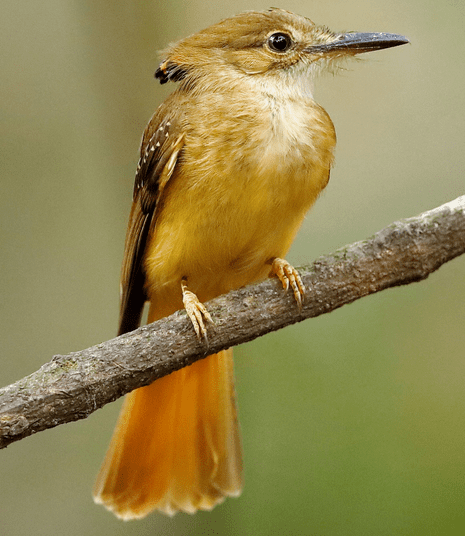With its distinctive crest of feathers and bold markings, the royal flycatcher stands out in the forest. Beyond this striking appearance, this bird is also known for its remarkable nesting behavior. Let’s learn more about this species through some interesting facts below!
Class: Aves
Order: Passeriformes
Family: Tityridae
Genus: Onychorhynchus
1. Royal flycatchers have a fan on their head
Belonging to the Tityridae family, the royal flycatcher is a tyrant flycatcher bird with medium size. They have a size of 6-7 inches in length. It boasts a large head with a long bill and a thin neck, long wings, and a short tail.
There are 4 royal flycatcher species: the Amazonian royal flycatcher (Onychorhynchus coronatus), Atlantic royal flycatcher (Onychorhynchus swainsoni), Pacific royal flycatcher (Onychorhynchus occidentalis), and Northern royal flycatcher (Onychorhynchus mexicanus).

These species come in dull brown color in their upper part, while the underside is orange-ochraceous. They have a whitish throat and a reddish or crimson tail and rump.
The royal flycatcher’s most distinctive trait is its fan-shaped crest. The males possess a crest in red, black, and blue hues, whereas the females have blue, yellow-orange, and black crests. The crest is elaborate and lengthy, lying flat before raising like a fan, which gives their head a hammerhead shape.
Their beautiful crest looks like a regal crown, that’s how these birds earned their name.
2. Diet
Royal flycatchers are insectivores that mostly eat flying insects, including moths, cicadas, flies, butterflies, and dragonflies. Like other flycatchers, they are equipped with long and broad bills that allow them to catch these insects mid-air.

These birds can be found near water, searching for food by capturing insects in the air or picking them off leaves. They also search for ticks, leafhoppers, butterflies, and small cicadas in the forest understory alone. Instead of sallying out to capture insects, they spend much of their time perching and looking for food.
These flycatchers can be eaten by big birds of prey such as hawks, eagles, owls, and falcons. Their eggs are vulnerable to larger birds and snakes.
3. Habitat
As the name suggests, the natural habitat of the Amazonian flycatcher bird spans across the Amazon Basin. They can be found in Venezuela, eastern Colombia, western Brazil, the Guianas, eastern Ecuador, northern and northern Bolivia, and eastern Peru.
The Atlantic flycatchers inhabit the Atlantic forest of southeastern Brazil, whereas the Northern birds can be found from Mexico, spreading southward through most of Central America to northwestern Colombia and far western Venezuela. On the other hand, the Pacific species is located in Western Ecuador and northwestern Peru.
(They are among 900 bird species in Costa Rica)
These birds typically live in wet deciduous lowland forests, rainforests, and woodlands.
4. Behavior
The birds can be seen alone or in pairs, but they prefer to remain solitary. Most of the time, they’re usually silent and unobtrusive. To communicate with each other, these flycatchers emit slow and mournful whistles.
The most highlighted characteristic of the birds is their crest. However, you can barely see their remarkable and vibrant crown fully displayed. They just show their crest in the mating season to attract partners. This colorful crest may be also used to frighten or temporarily repel some predators like mammals or avian species.
Royal flycatchers are considered nonmigratory and reside in their South American habitat for the entire year.
Recommended
👁 225,109 views

▶ 1,034,201 plays

5. Their nest is super long
The royal flycatcher, like any other bird, has four-stage life cycles. They breed from October to June, in damp riparian forest settings near bodies of water. The males show off their brilliantly colored crest to woo females.
After mating, the females make a nest. Unlike other birds, their nest is not located on trees. It is suspended from vines and twigs, around 2-6 meters above the ground or water. This is a defense tactic to protect their offspring. This nest, made of moss, rootlets, plant fibers, and leaves, is approximately 78.7 inches (2 meters) long.

After laying 2 brown eggs, females spend 60% of the day incubating them for 22 days, taking care of and feeding the young ones once they hatch. The males don’t participate in those duties, but instead, protect the nesting territory during the nesting season.
As soon as the young are ready to fly, they leave their nest. These birds do not fly further south from their breeding grounds.
The lifespan of the royal flycatcher is quite long. They can live for 6 years.
6. Conservation status
The Amazonian royal flycatcher has been classified as Least Concern by the IUCN. Their population is about 500,000 to 5 million adult birds. Despite this, the population of this species is declining, largely due to the loss of its wetland and forest habitats from deforestation.
Like the Amazonian flycatcher, the northern bird is also listed ad Least Concern. However, their other two cousins are not lucky like that.
The Atlantic royal flycatcher and the Pacific royal flycatcher have both been classified as Vulnerable by the IUCN. Although the Atlantic species has been found in new locations, its population is estimated to be decreasing rapidly with only 600-1,700 mature individuals remaining.
References:

